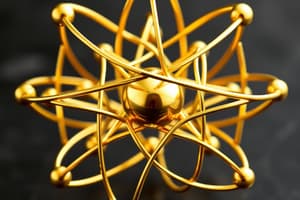Podcast
Questions and Answers
What did the Geiger-Marsden experiment reveal about the structure of the atom?
What did the Geiger-Marsden experiment reveal about the structure of the atom?
- Electrons are located in fixed orbits.
- Atoms are composed entirely of protons.
- Atoms contain only neutrons.
- Atoms have a dense nucleus and are mostly empty space. (correct)
The Quantum Mechanical Model defines the exact path of an electron around the nucleus.
The Quantum Mechanical Model defines the exact path of an electron around the nucleus.
False (B)
Who discovered the neutron?
Who discovered the neutron?
James Chadwick
The _____ model introduced by Erwin Schrodinger describes the likelihood of finding an electron in a certain position.
The _____ model introduced by Erwin Schrodinger describes the likelihood of finding an electron in a certain position.
Match the physicist to their major contribution:
Match the physicist to their major contribution:
What concept did James Chadwick's discovery of neutrons help explain?
What concept did James Chadwick's discovery of neutrons help explain?
Electrons are found in fixed orbits according to the Quantum Mechanical Model.
Electrons are found in fixed orbits according to the Quantum Mechanical Model.
What significant project did James Chadwick work on during WWII?
What significant project did James Chadwick work on during WWII?
Study Notes
Ernest Rutherford and the Gold Foil Experiment
- Conducted the Geiger-Marsden experiment (also known as the gold foil experiment).
- Demonstrated the nuclear nature of atoms.
- Showed that most alpha particles passed through a thin gold foil, indicating that atoms are mostly empty space.
- This experiment led to the discovery of the atom's dense, positively charged nucleus.
- Previously worked with J.J. Thomson on X-rays and gases, contributing to the discovery of the electron (1897).
Erwin Schrödinger and the Quantum Mechanical Model
- Developed the quantum mechanical model of the atom, building upon the Bohr model.
- Used mathematical equations to describe the probability of finding an electron in a specific location.
- This model doesn't define a precise electron path but predicts the likelihood of its position.
- Electron probability is highest where the electron cloud is densest.
- Introduced the concept of sub-energy levels, reinforcing the idea of electrons existing in specific energy states.
- Showed that electrons behave like three-dimensional waves, enabling the description of their size, shape, and spatial orientation.
James Chadwick and the Discovery of the Neutron
- Discovered the neutron in 1932.
- Worked as Rutherford's assistant.
- His experiment involved bombarding paraffin wax with radiation.
- Measured unknown radiation with the same mass as a proton but no charge, thus discovering the neutron.
- This discovery was crucial for the Manhattan Project and the development of the atomic bomb.
- The discovery led to a revised atomic model (sometimes called the James Chadwick atomic model), explaining the existence of isotopes (elements with varying neutron numbers).
Studying That Suits You
Use AI to generate personalized quizzes and flashcards to suit your learning preferences.
Description
Explore the groundbreaking contributions of Ernest Rutherford and Erwin Schrödinger to atomic theory. Learn about Rutherford's gold foil experiment that revealed the atomic nucleus and Schrödinger's quantum mechanical model that introduced the concept of electron probability. This quiz will enhance your understanding of modern atomic structure.




